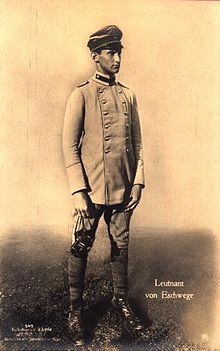Rudolf von Eschwege
| Rudolf von Eschwege | |
|---|---|
 |
|
| Nickname(s) | "Rudi", "The Eagle of the Aegean Sea", "The Richthofen of the Balkans" |
| Born | 25 February 1895 Bad Homburg vor der Höhe, Germany |
| Died | 21 November 1917 (aged 22) Orljak, Macedonia |
| Allegiance | Germany |
| Service/branch | Cavalry; aviation |
| Rank | Leutnant |
| Unit | 3rd Mounted Jaeger Regiment, FA 36, FA 66, FA 30 |
| Awards | Royal House Order of Hohenzollern, Iron Cross |
Leutnant Rudolf von Eschwege was a German World War I flying ace who was the German Empire's only fighter pilot operating on the Macedonian Front. He was credited with twenty confirmed and six unconfirmed victories.
"Rudi" von Eschwege was born in Bad Homburg vor der Höhe, the German Empire, on 25 February 1895. He was orphaned while young. He went to military school after completing his secondary education at Freiburg. When World War I began, he was a nineteen-year-old cadet of medium height and slender build with blue eyes. Eschwege began his combat career as an ensign with the 3rd Mounted Jaeger Regiment on the Western Front. On 9 and 10 August 1914, he fought in the Battle of Mulhouse; later, he also fought along the River Yser.
After three months, he transferred to aviation. By February 1915, he began pilot training. He was not a natural pilot, but managed to qualify after crashing several times. He was then assigned to Flieger-Abteilung 36, an aerial reconnaissance unit, in July 1915. By July 1916, he was flying a Fokker Eindekker as a fighter escort to the unit's two-seaters. He served there until autumn of 1916, when he was commissioned an officer and transferred to the Macedonian Front.
There, on the fringes of the great war, a polyglot air force of Turks, Germans, and Bulgarians battled a vastly numerically superior French and Franco-Serbian foe. There, Eschwege was assigned to another recon unit, FA 66. His brief was to patrol a 99 mile long front and guard the Bulgarian 10th Aegean Division against enemy air activities. There were a total of three German reconnaissance units in the theater, but he was the sole German fighter pilot. Opposed to him were two Royal Naval Air Service Wings, Nos. 2 and 3; two Royal Flying Corps squadrons, Nos. 17 and 24; as well as about 160 French and Serbian airplanes, equivalent to another ten squadrons. On 25 October 1916, piloting a Fokker Eindekker, he put in his first claim for an aerial victory when he "splashed" a Farman, but it went unconfirmed because the Bulgarian witnesses at a ground observation post had been transferred. His next two, on 19 November and 27 December, were his first credited victories. The Bulgarian infantry began to refer to him as "The Eagle of the Aegean Sea".
...
Wikipedia
